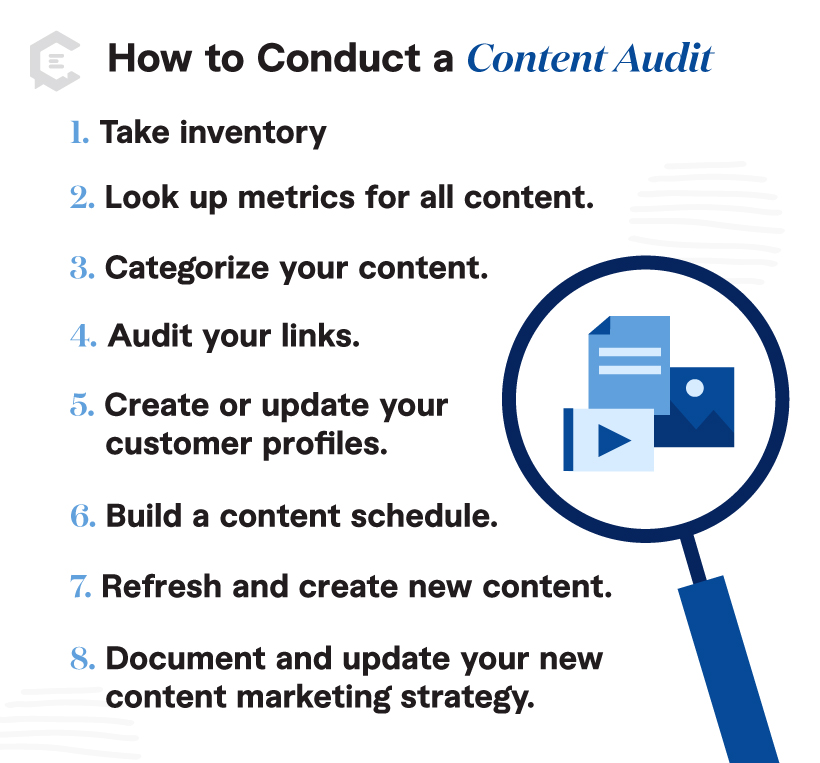What Is a Content Audit?
A content audit is a look at what content you currently have published, how it’s performing, any issues that could be affecting its efficacy, and how it impacts the user experience. A content audit analyzes your content efforts so you can evaluate your strategy to understand what’s working and what’s not. This will help you make more informed content marketing decisions in the future and fix any issues impacting performance right now.

Why Are Content Audits so Important?
You know how much time, effort, and resources it takes to create great content. However, not all content ages well or meets performance expectations. Maybe you’ve had a rebrand. Maybe you’ve some expired links that are affecting your SEO. Maybe the topic is great, but the copy could use a little zhuszh.
A content audit will tell you exactly what needs fixing and what doesn’t. You will also be able to answer the following questions:
- Which content is generating the most traffic?
- Which content is the most popular and most read among my audience?
- Which content do visitors spend the most time reading?
- Which content is generating the most social engagement?
Having these answers is essential to making decisions impacting the future of your content. Or, put another way: you can’t get where you want to go if you don’t know where you are. Your content audit gives you your starting point.
Key Elements of an Effective Content Audit
Before you begin the content audit itself, you’ll need to establish your goals for the project. This way, you’ll know which data points you actually want to look at. Are you looking to improve your SEO rankings? Boost conversions? Increase audience engagement? Each of these goals will have different metrics associated with them.
So, once you’ve established your goals, you’ll decide on which metrics you’ll be measuring. These might include:
- Average time on page
- Duplicate content
- Organic traffic
- Backlinks
- Keyword rankings
- Bounce rate
- Page views
- Average session duration
- Likes, shares, and mentions
- Internal links
- Leads and conversions
How to Conduct a Content Audit
Now it’s time to conduct your content audit, which should consist of the following steps:
- Take inventory. A content audit involves all your existing content. You can create this list in an Excel spreadsheet, a project or task management tool, a digital asset management system, or whatever works best for you and your team.
- Look up metrics for all content. Using tools like HubSpot or Google Analytics, you can look at your website’s analytics and see which content generates the most page views, which content your visitors spend the most time reading, and which content results in the most conversions. Enter this information into your spreadsheet.
- Categorize your content. Depending on how much content you have in your inventory, you can either categorize by content type or by content topic.
- Audit your links. Broken links or outbound links to outdated or less-than-reputable content can hurt your SEO, ultimately hurting your content’s overall performance.
- Create or update your customer profiles. Once you understand what content is the most popular and what isn’t, you can determine who your customers are and what interests them. Update your customer personas accordingly.
- Build a content schedule. Schedule some time each month to review metrics for content published during the previous month and to also develop content for the upcoming month. Be sure to also consider upcoming events, seasons, and holidays.
- Refresh and create new content. By this step, you’ve probably noticed a gap in your existing content and your ideal customer profile, so it’s time to either refresh and update old content and/or create new content.
- Document and update your new content marketing strategy. With everything you’ve learned throughout the process, you are now in a better and more confident position to revamp your content marketing strategy for the future.
Conduct Your Content Audit Today
At ClearVoice, we offer content audit and gap analysis services that will examine your existing on-site content. If you don’t have the proper resources or time to do a full content audit and need some expert help, then maybe this is what you need.
Or maybe you’ve already identified your gaps and need help with content refreshes and new content pieces. ClearVoice has you covered there, too.
With ClearVoice as your managed content solution, we create a custom content plan based on your needs and resources so you never pay for content you don’t need or won’t use. Talk to a content specialist today and start closing those content gaps!






